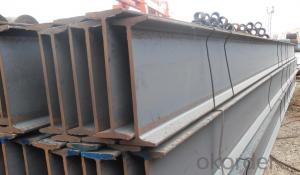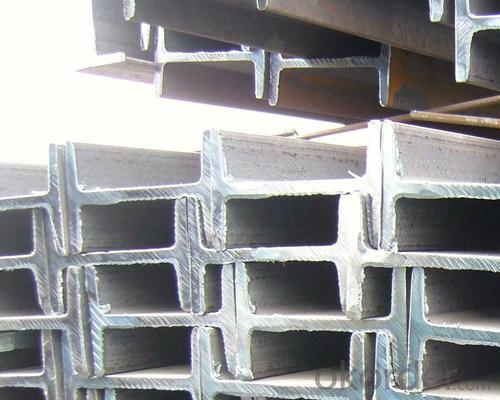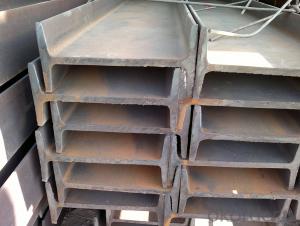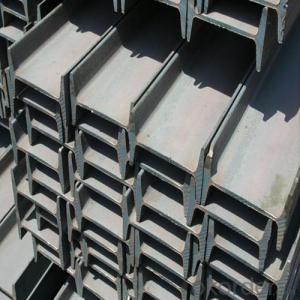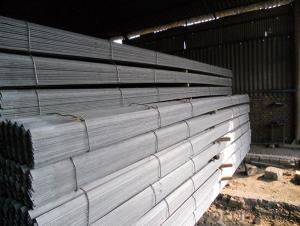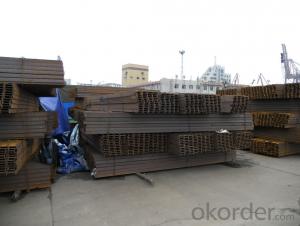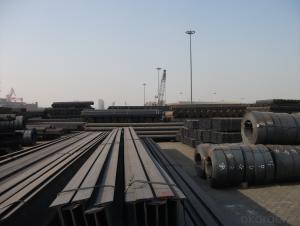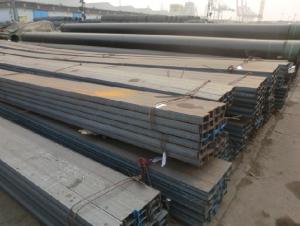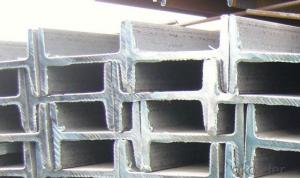High quality IPEAA
- Loading Port:
- China Main Port
- Payment Terms:
- TT OR LC
- Min Order Qty:
- -
- Supply Capability:
- -
OKorder Service Pledge
OKorder Financial Service
You Might Also Like
Product Description:
IPEAA Beam Details:
| Minimum Order Quantity: | 10MT | Unit: | m.t. | Loading Port: | Tianjin Port, China |
| Supply Ability: | 10000MT | Payment Terms: | TT or LC | | |
Product Description:
Specifications of IPEAA Beam
1. Invoicing on theoretical weight or actual weight as customer request
2. Standard: EN10025, GB Standard, ASTM
3. Grade: Q235B, Q345B, SS400, ASTM A36, S235JR, S275JR
4. Length: 5.8M, 6M, 9M, 12M as following table
5. Sizes: 80mm-270mm
Dimensions(mm) | |||||
| h | b | s | t | Mass Kg/m |
IPEAA80 | 80 | 46 | 3.80 | 5.20 | 6.00 |
IPEAA100 | 100 | 55 | 4.10 | 5.70 | 8.10 |
IPEAA120 | 120 | 64 | 4.80 | 6.30 | 10.40 |
IPEAA140 | 140 | 73 | 4.70 | 6.90 | 12.90 |
IPEAA160 | 160 | 82 | 5.00 | 7.40 | 15.80 |
IPEAA180 | 180 | 91 | 5.30 | 8.00 | 18.80 |
IPEAA200 | 200 | 100 | 5.60 | 8.50 | 22.40 |
IPEAA220 | 220 | 110 | 5.90 | 9.20 | 26.20 |
IPEAA240 | 240 | 120 | 6.20 | 9.80 | 30.70 |
IPEAA270 | 270 | 135 | 6.60 | 10.20 | 36.10 |
Appications of IPEAA Beam
1. Supporting members, most commonly in the house raising industry to strengthen timber bears under houses. Transmission line towers, etc
2. Prefabricated structure
3. Medium scale bridges
4. It is widely used in various building structures and engineering structures such as roof beams, bridges, transmission towers, hoisting machinery and transport machinery, ships, industrial furnaces, reaction tower, container frame and warehouse etc.
Package & Delivery of IPEAA Beam
1. Packing: it is nude packed in bundles by steel wire rod
2. Bundle weight: not more than 3.5MT for bulk vessel; less than 3 MT for container load
3. Marks: Color marking: There will be color marking on both end of the bundle for the cargo delivered by bulk vessel. That makes it easily to distinguish at the destination port.
4. Tag mark: there will be tag mark tied up on the bundles. The information usually including supplier logo and name, product name, made in China, shipping marks and other information request by the customer.
If loading by container the marking is not needed, but we will prepare it as customer request.
5. Transportation: the goods are delivered by truck from mill to loading port, the maximum quantity can be loaded is around 40MTs by each truck. If the order quantity cannot reach the full truck loaded, the transportation cost per ton will be little higher than full load.
6. Delivery of IPE Beam: 30 days after getting L/C Original at sight or T/T in advance
Production flow of IPEAA Beam
Material prepare (billet) —heat up—rough rolling—precision rolling—cooling—packing—storage and transportation
- Q: How do engineers determine the appropriate size of steel I-beams for a specific application?
- Engineers determine the appropriate size of steel I-beams for a specific application by considering various factors such as the load requirements, span length, and the type of structure. They use structural analysis techniques and mathematical calculations to determine the maximum bending moment, shear force, and deflection that the I-beam will experience. By evaluating these factors, engineers can select an I-beam size that can safely support the load and meet the structural and safety requirements of the application.
- Q: How do steel I-beams compare to fiberglass I-beams in terms of strength and durability?
- Steel I-beams are generally considered to be stronger and more durable than fiberglass I-beams. Steel is a much stronger material compared to fiberglass, which means that steel I-beams can bear heavier loads and withstand more stress without deforming or breaking. Additionally, steel has a higher resistance to fire, extreme temperatures, and chemicals, which further enhances its durability. Fiberglass I-beams, on the other hand, are lighter and more flexible than steel I-beams. This makes them suitable for certain applications where weight is a concern or where flexibility is required. Fiberglass I-beams also have excellent corrosion resistance, making them ideal for environments that are exposed to chemicals or moisture. While fiberglass I-beams can be a cost-effective and corrosion-resistant alternative to steel in certain situations, they cannot match the strength and durability of steel I-beams in heavy-duty applications. Steel I-beams are commonly used in construction projects that require high load-bearing capacities, such as skyscrapers, bridges, and industrial buildings. In these scenarios, the superior strength and durability of steel make it the preferred choice.
- Q: How are steel I-beams used in construction?
- Steel I-beams are commonly used in construction as structural support elements. They are characterized by their distinctive I shape, which allows them to bear heavy loads over long spans. I-beams are positioned horizontally and are often integrated into the framework of buildings, bridges, and other structures to provide strength and stability. They can support walls, floors, roofs, and even entire buildings, making them an essential component in the construction industry.
- Q: Can steel I-beams be used for retaining walls or foundation support?
- No, steel I-beams are not typically used for retaining walls or foundation support. These types of structures require specific materials, such as reinforced concrete, that can provide the necessary strength, stability, and durability to withstand the forces exerted by the soil and other external factors.
- Q: Can Steel I-Beams be used for conveyor systems?
- Yes, steel I-beams can be used for conveyor systems. Steel I-beams are known for their high strength and durability, making them suitable for supporting heavy loads in conveyor applications. They provide excellent structural support and can withstand the constant movement and weight of conveyor belts and materials being transported. Additionally, steel I-beams can be easily customized to fit specific conveyor system requirements, such as length, width, and height. Their versatility and reliability make them a popular choice for conveyor systems across various industries.
- Q: What is the maximum span length that steel I-beams can support?
- The maximum span length that steel I-beams can support depends on various factors such as the type and size of the beam, the load it is intended to carry, and the design specifications. It is not possible to provide a specific maximum span length without considering these variables. Professional engineers and structural designers typically calculate the appropriate span length based on these factors to ensure structural integrity and safety.
- Q: How do steel I-beams perform in terms of deflection or bending?
- Steel I-beams perform very well in terms of deflection or bending. Due to their structural design and the inherent strength of steel, I-beams offer excellent resistance to deflection and bending forces. This makes them highly suitable for supporting heavy loads and maintaining structural integrity in various construction and engineering applications.
- Q: How do steel I-beams contribute to the overall durability and longevity of a structure?
- Steel I-beams contribute to the overall durability and longevity of a structure due to their high strength-to-weight ratio and resistance to bending and deflection. These beams provide structural support by distributing the weight of the load evenly, minimizing the risk of structural failure and collapse. Additionally, their ability to withstand extreme weather conditions, corrosion, and fire makes them highly durable, ensuring the longevity of the structure.
- Q: How do steel I-beams perform in terms of impact resistance?
- Steel I-beams are known for their exceptional impact resistance. Due to their shape and composition, they can withstand high levels of force and distribute the impact energy efficiently, making them highly resistant to deformation or failure. This makes steel I-beams a reliable choice for applications that require structural stability and protection against impact, such as in construction, bridges, and heavy machinery.
- Q: Can steel I-beams be used for soundproofing or acoustical applications?
- Steel I-beams are not typically utilized for soundproofing or acoustical purposes. They serve as structural components in construction, providing support and stability to buildings, bridges, and other structures. Their design does not specifically address sound transmission or control. In the realm of soundproofing or acoustical applications, alternative materials and techniques are commonly employed. These may include insulation materials like fiberglass or mineral wool, which are designed to absorb sound and reduce its transmission. Additionally, specialized acoustic panels or soundproofing systems, such as resilient channels or double stud walls, are commonly utilized to create sound barriers and minimize sound transfer between spaces. While steel I-beams may offer some sound reduction due to their mass and density, they are not the most effective solution for soundproofing or acoustical purposes. Therefore, if sound control is the primary objective, it is recommended to explore alternative materials and methods specifically designed for this purpose.
Send your message to us
High quality IPEAA
- Loading Port:
- China Main Port
- Payment Terms:
- TT OR LC
- Min Order Qty:
- -
- Supply Capability:
- -
OKorder Service Pledge
OKorder Financial Service
Similar products
Hot products
Hot Searches
Related keywords


